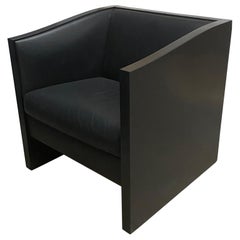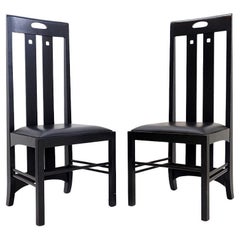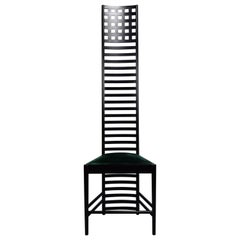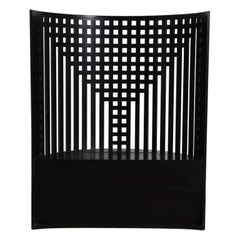Charles Rennie Mackintosh Club Chairs
At the turn of the 20th century, the Scottish architect Charles Rennie Mackintosh created a singular, wholly original design style that was both lyrical and sleekly modern. Within his architectural schemes for schools, private homes and restaurants, Mackintosh — frequently working in collaboration with his wife, the artist Margaret Macdonald — invented an aesthetic that blends the organic flow of the Art Nouveau style and the honest simplicity of the English Arts & Crafts movement.
Mackintosh was born into a working-class Glasgow family, the fourth of the 11 children of a police clerk and his wife. At age 15, Mackintosh began to take night classes at the Glasgow School of Art — where he would study until 1894 — and the following year started an apprenticeship with local architect John Hutchison.
At the GSA, Mackintosh befriended Macdonald, her sister, Frances, and fellow architecture student Herbert McNair. Together they formed a graphic design team known as the Four, and were admired for their illustrations featuring sinuous botanical forms and sylph-like women. Around the same time, Mackintosh was hired by the architectural firm Honeyman and Keppie. where he drafted the company’s winning design for a new GSA building. The structure, with its brooding, asymmetrical facade punctuated by soaring studio windows, would be his architectural masterwork. By 1900, Mackintosh was designing houses and began the interiors for a group of Glasgow tea parlors in which he and Macdonald would produce some of the most alluring, lushly graphic decors of the era. Mackintosh’s work became widely influential on the continent, particularly among Josef Hoffmann, Koloman Moser and other members of the Vienna Secession movement.
His work on private homes and tearooms generated the furniture designs for which Mackintosh is best known today. These include the Hill House chair, with its latticed back; the Argyle Street Tea Room chair, which features an oval head rail with a cutout that resembles a bird in flight; and several others — all instantly recognizable for their stunning tall backs.
Mackintosh’s furniture works well in both traditional and modern interiors, though by virtue of both its familiarity and striking lines it tends to stand out. Because he was much more esteemed in Europe than in Britain, relatively few antique Mackintosh works survive, and those that have are museum pieces. Recently produced examples of his designs are widely available — notably, the Italian firm Cassina has been making fine Mackintosh pieces since the early 1970s. As you will see on 1stDibs, the furniture of Charles Rennie Mackintosh is ever intriguing and engaging. His work is a historical touchstone that would be welcome in the home of any modern design aficionado.
Early 20th Century Modern Charles Rennie Mackintosh Club Chairs
Upholstery
20th Century Italian Modern Charles Rennie Mackintosh Club Chairs
Leather, Wood
1980s Italian Art Nouveau Vintage Charles Rennie Mackintosh Club Chairs
Velvet, Wood
1980s American Modern Vintage Charles Rennie Mackintosh Club Chairs
Fabric, Ash
1970s Italian Bauhaus Vintage Charles Rennie Mackintosh Club Chairs
Chrome
2010s Italian Mid-Century Modern Charles Rennie Mackintosh Club Chairs
Velvet, Wood
1970s Italian Mid-Century Modern Vintage Charles Rennie Mackintosh Club Chairs
Wood
1980s Italian Mid-Century Modern Vintage Charles Rennie Mackintosh Club Chairs
Leather, Wood
20th Century Italian Art Nouveau Charles Rennie Mackintosh Club Chairs
Sheepskin, Wood
2010s Italian Mid-Century Modern Charles Rennie Mackintosh Club Chairs
Wood
21st Century and Contemporary Asian William IV Charles Rennie Mackintosh Club Chairs
Leather
21st Century and Contemporary Italian Charles Rennie Mackintosh Club Chairs
Wood, Velvet
1980s British Mid-Century Modern Vintage Charles Rennie Mackintosh Club Chairs
Fabric, Ash
1970s Italian Mid-Century Modern Vintage Charles Rennie Mackintosh Club Chairs
Ash
Early 20th Century Italian Charles Rennie Mackintosh Club Chairs
Ash
Charles Rennie Mackintosh club chairs for sale on 1stDibs.
- 1stDibs ExpertApril 5, 2022Charles Rennie Mackintosh was a Scottish architect who created an original design style that is sleek and modern. He is best known for his chair designs, which feature high backs and striking lines. Browse a variety of Mackintosh furniture and chairs on 1stDibs.
- 1stDibs ExpertFebruary 13, 2024No, Charles Rennie Mackintosh is generally not considered Art Deco. His early work is usually categorized as Art Nouveau and provided a source of inspiration for Josef Hoffmann, Koloman Moser and other members of the Vienna Secession movement, which is closely related to the Art Nouveau movement. Pieces produced later in the Scottish designer's career, such as those from the Italian firm Cassina, show off the characteristics of mid-century modern design. On 1stDibs, find an assortment of Charles Rennie Mackintosh furniture.
- 1stDibs ExpertMarch 13, 2024No, Charles Rennie Mackintosh's work isn't Art Deco. The architect and designer developed an aesthetic that blends the organic flow of the Art Nouveau style with the honest simplicity of the English Arts & Crafts movement. Mackintosh’s furniture works well in both traditional and modern interiors, where, by virtue of its familiarity and striking lines, it tends to stand out. Explore a variety of Charles Rennie Mackintosh furniture on 1stDibs.
- 1stDibs ExpertJanuary 19, 2025Charles Mackintosh was famous for his work as a designer and architect. At the turn of the 20th century, he created a singular, wholly original design style that was both lyrical and sleekly modern. Within his architectural schemes for schools, private homes and restaurants, he — frequently working in collaboration with his wife, the artist Margaret Macdonald — invented an aesthetic that blended the organic flow of Art Nouveau and the honest simplicity of the English Arts & Crafts movement. Shop a collection of Charles Rennie Mackintosh furniture on 1stDibs.




